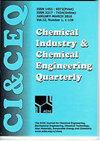小球藻的电化学收获:电解液浓度和电极间距
IF 0.8
4区 工程技术
Q4 CHEMISTRY, APPLIED
Chemical Industry & Chemical Engineering Quarterly
Pub Date : 2023-01-01
DOI:10.2298/ciceq210815010a
引用次数: 1
摘要
本文研究了两种电化学收集微藻的方法。采用牺牲阳极(铝)研究电絮凝浮选工艺,采用非牺牲阳极(石墨)研究电浮选工艺。考察了氯离子浓度和电极间距对电化学捕集性能的影响。结果表明,当NaCl浓度为2 g/L时,两个电极的收获效率最高。有趣的是,当NaCl浓度增加到5 g/L时,收获效率急剧下降到最低值。总体上,随着NaCl浓度的增加,能量消耗降低。此外,铝阳极的能耗比石墨阳极低。然而,通过将电极之间的间隙从15毫米增加到30毫米,实现最大效率所需的时间增加了一倍,并且能耗也随之增加。本文章由计算机程序翻译,如有差异,请以英文原文为准。
Electrochemical harvesting of Chlorella sp.: Electrolyte concentration and interelectrode distance
Two modes of electrochemical harvesting for microalgae were investigated in the current work. A sacrificial anode (aluminum) was used to study the electrocoagulation-flotation process, and a nonsacrificial anode (graphite) was used to investigate the electroflotation process. The study inspected the effect of chloride ions concentration and the interelectrode distance on the performance of the electrochemical harvesting processes. The results demonstrated that both electrodes achieved maximum harvesting efficiency with a 2 g/L NaCl concentration. Interestingly, by increasing the NaCl concentration to 5 g/L, the harvesting efficiency reduced dramatically to its lowest value. Generally, the energy consumption decreased with increasing of NaCl concentration. Moreover, the energy consumption achieved with aluminum anodes is lower than that achieved with graphite. However, by increasing the gap between the electrodes from 15 mm to 30 mm, the time required to achieve the maximum efficiency doubled, and energy consumption increased consequently.
求助全文
通过发布文献求助,成功后即可免费获取论文全文。
去求助
来源期刊

Chemical Industry & Chemical Engineering Quarterly
CHEMISTRY, APPLIED-ENGINEERING, CHEMICAL
CiteScore
2.10
自引率
0.00%
发文量
24
审稿时长
3.3 months
期刊介绍:
The Journal invites contributions to the following two main areas:
• Applied Chemistry dealing with the application of basic chemical sciences to industry
• Chemical Engineering dealing with the chemical and biochemical conversion of raw materials into different products as well as the design and operation of plants and equipment.
The Journal welcomes contributions focused on:
Chemical and Biochemical Engineering [...]
Process Systems Engineering[...]
Environmental Chemical and Process Engineering[...]
Materials Synthesis and Processing[...]
Food and Bioproducts Processing[...]
Process Technology[...]
 求助内容:
求助内容: 应助结果提醒方式:
应助结果提醒方式:


